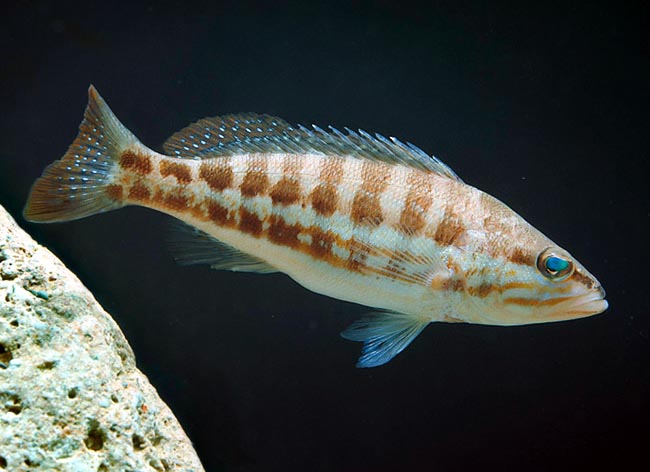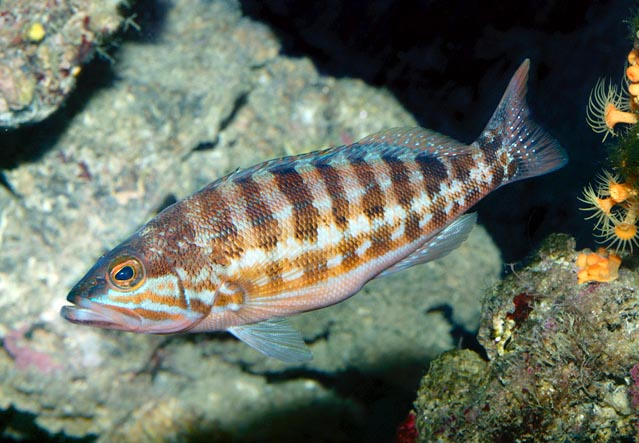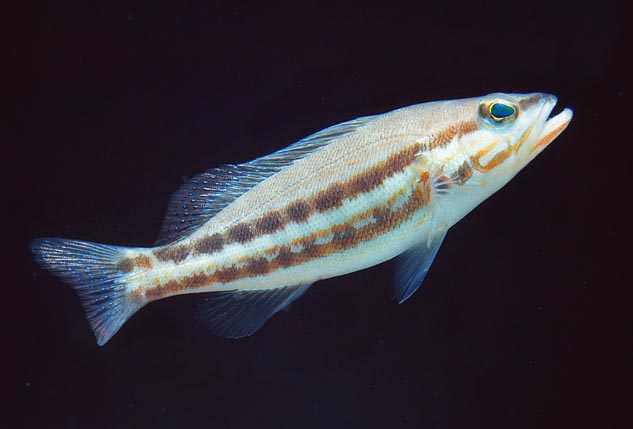Family : Serranidae

Text © Giuseppe Mazza

English translation by Mario Beltramini

The Comber (Serranus cabrilla) common in Mediterranean and East Atlantic, is a hermaphrodite species © Mazza
The name of the genus comes from the Latin “serra” = saw, with reference to the saw-toothed dorsal fin, not to mention the various spines. The specific epithet cabrilla is the diminutive for the Latin word “capra” = goat, in reference to its way of swimming, with twitchs and jumps, like a kid.
Zoogeography
It is present all over the Mediterranean and in the northern part of the Red Sea. After Gibraltar Strait, it has an extremely vast diffusion on the eastern Atlantic coast, from the North Sea to the Cape of Good Hope, including the Azores, Madeira, Cape Verde and the Canary Islands. Then, it goes northward along Africa, in the Indian Ocean up to Mozambique.
Ecology-Habitat
Unlike the Serranus scriba who keeps stuck to the rocky coasts, in relatively shallow waters, the Serranus cabrilla loves muddy bottoms and reaches the 500 m of depth, but can also share with its congener the prairies of Posidonias (Posidonia oceanica).

The livery is mimetic, very variable, and depends on the season, age and location © Giuseppe Mazza
Like this one, it loves the solitary life with its den, maybe under a stone, at the centre of a small hunting territory.
Morpho-physiology
Like this one, it loves the solitary life with its den; it measures about 25 cm, and even less in the Mediterranean.
The body is more slender than that of the Serranus scriba but it has the same spiny structure. One large dorsal fin with 10 spines and 13-15 soft rays, a shorter anal with 3 spines and 7-8 unarmed rays and the ventral ones with one spine only.
Also in this case the pectoral fins are spatulate, but the caudal is emarginate. Also, the operculum shows 3 spines looking towards the tail and the preoperculum is jagged on the rear edge.
The colour changes depending on the seasons, the age, but, mainly, on the environment where it lives. For mimetic reasons, the specimens of the muddy bottoms have faded tints, whilst those living amongst the corals brighten their colours and in the posidonias beds the vertical bands become more marked. In the whole, we can say that the livery goes from the reddish-brown to the yellow, with 7-9 dark vertical bands, crossed in the middle by a horizontal clear stripe, relatively wide, and by other two, thinner, less evident. They concern also the operculum, where their tendency to the light blue is more marked.

Youngs have only two longitudinal bands, those living on muddy bottoms at 500 m have faded colours © Mazza
Ethology-Reproductive Biology
Not less greedy than this last one, it hunts small fishes, cephalopods and crustaceans, enriching, at times, its diet with some annelids.
Like the Serranus scriba the Serranus cabrilla is a hermaphroditic species. The eggs and the sperm mature at the same time, and the self-fecundation is therefore, theoretically possible.
In the Mediterranean, it reproduces during the summer, starting from the 17-18 cm of length.
The eggs are pelagic and when the young reach the 2,5 cm, they already look like the adults, with two longitudinal bands going from the head to the tail.
The vulnerability index of this species is of 36 over 100.
Synonyms
Paracentropristis cabrilla Linnaeus, 1758; Perca cabrilla Linnaeus, 1758; Serranus knysnaensis Gilchrist, 1904.
→ For general information about FISH please click here.
→ For general information about BONY FISH please click here
→ For general information about CARTILAGINOUS FISH please click here.
→ To appreciate the BIODIVERSITY of BONY FISH please click here.
→ To appreciate the BIODIVERSITY of CARTILAGINOUS FISH please click here.
